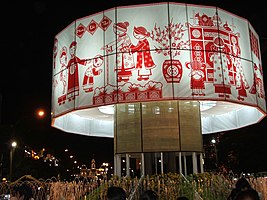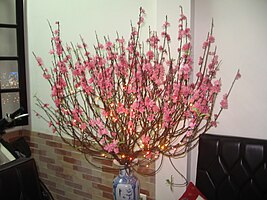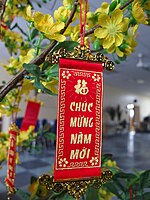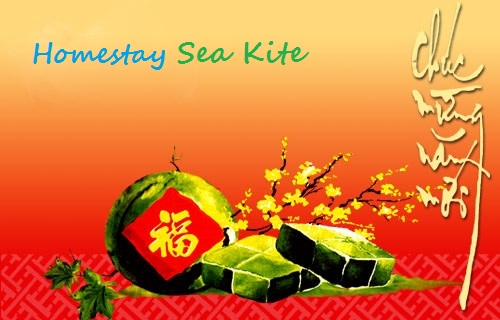Vietnamese Lunar New Year
February 2016, Da Nang City, Viet Nam
February 2016, Da Nang City, Viet Nam
Tết ([tet˧˥] or [tɜːt˧˥]), or Vietnamese New Year, is the most important celebration in Vietnamese culture. The word is a shortened form of Tết Nguyên Đán (Nôm: 節元旦), which is Sino-Vietnamese for "Feast of the First Morning of the First Day". Tết celebrates the arrival of spring based on the Vietnamese variation of the Chinese lunisolar calendar, which usually has the date falling in January or February.
Tết is generally celebrated on the same day as Chinese New Year, except when the one-hour time difference betweenVietnam and China results in new moon occurring on different days. It takes place from the first day of the first month of the Vietnamese calendar (around late January or early February) until at least the third day. Many Vietnamese prepare for Tết by cooking special holiday foods and cleaning the house. These foods include bánh chưng, bánh dày, dried young bamboo soup (canh măng), giò, and sticky rice. Many customs are practiced during Tết, such as visiting a person's house on the first day of the new year (xông nhà), ancestor worship, wishing New Year's greetings, giving lucky money to children and elderly people, and opening a shop.
Tết is also an occasion for pilgrims and family reunions. During Tết, Vietnamese visit their relatives and temples,and start forgetting about the troubles of the past year and hoping for a better upcoming year. They consider Tết to be the first day of spring and the festival is often called Hội xuân (spring festival).
Vietnamese people usually return to their families during Tết. Some return to worship at the family altar or visit the graves of their ancestors in their homeland. They also clean the graves of their family as a sign of respect. Although Tết is a national holiday among all Vietnamese, each region and religion has its own customs.
Tết in the three Vietnamese regions can be divided into three periods, known as Tất Niên (penultimate New Year's Eve), Giao Thừa (New Year's Eve), and Tân Niên (the New Year), representing the preparation before Tết, the eve of Tết, and the days of and following Tết, respectively.
Before New Year's Eve
This period begins one or two weeks before the actual celebration. The general atmosphere leading up to Tết is in the bustle of shopping, decorating the home, cooking traditional Tết food, and waiting for relatives to return home. People try to pay off their debts in advance so they can be debt-free on Tết. Parents buy new clothes for their children so the children can wear them when Tết arrives. In the days leading up to Tết, the streets and markets are full of people. As the shops will be closed during Tết, people try to stock up on supplies as much as possible.
Vietnamese families usually have a family altar, to show respect to their ancestors. During Tết, the altar is thoroughly cleaned and new offerings are placed there. This includes a tray of five different fruits on the altar called "Mâm Ngũ Quả" (literally, five fruit types). Traditionally, the three kitchen guardians for each house (Ông Táo, Kitchen God), who report to the Jade Emperor about the events in that house over the past year, return to heaven on the 23rd day of the 12th month by lunar calendar. Their departure is marked by a modest ceremony where the family offers sacrifices for them to use on their journey.
In the days leading up to Tết, each family cooks special holiday foods such as bánh chưng and bánh dầy. Preparations for these foods are quite extensive. Family members often take turns to keep watch on the fire overnight, telling each other stories about Tết of past years.
Vietnamese families also buy home peach blossom trees, kumquat trees, and orange trees. They also buy flowers to decorate their homes such as chrysanthemums or orchids. They plant these flowers and put them into beautiful pots in front of or inside the house.
The New Year
The first day of Tết is reserved for the nuclear family. Children receive a red envelope containing money from their elders. This tradition is called mừng tuổi (happy new age) in the north and lì xi in the south. Usually, children wear their new clothes and give their elders the traditional Tết greetings before receiving the money. Since the Vietnamese believe that the first visitor a family receives in the year determines their fortune for the entire year, people never enter any house on the first day without being invited first. The act of being the first person to enter a house on Tết is called xông đất, xông nhà or đạp đất, which is one of the most important rituals during Tết. According to Vietnamese tradition, if good things come to the family on the first day of the lunar New Year, the entire following year will also be full of blessings. Usually, a person of good temper, morality, and success will be the lucky sign for the host family and be invited first into the house. However, just to be safe, the owner of the house will leave the house a few minutes before midnight and come back just as the clock strikes midnight to prevent anyone else entering the house first who might potentially bring any unfortunate events in the new year to the household.
Sweeping during Tết is taboo or xui (unlucky), since it symbolizes sweeping the luck away; that is why they clean before the new year. It is also taboo for anyone who experienced a recent loss of a family member to visit anyone else during Tết.
During subsequent days, people visit relatives and friends. Traditionally but not strictly, the second day of Tết is usually reserved for friends, while the third day is for teachers, who command respect in Vietnam. Local Buddhist temples are popular spots as people like to give donations and to get their fortunes told during Tết. Children are free to spend their new money on toys or on gambling games such as bầu cua cá cọp, which can be found in the streets. Prosperous families can pay for dragon dancers to perform at their house. Also, public performances are given for everyone to watch.
Traditional celebrations
These celebrations can last from a day up to the entire week, and the New Year is filled with people in the streets trying to make as much noise as possible using firecrackers, drums, bells, gongs, and anything they can think of to ward off evil spirits. This parade will also include different masks, and dancers hidden under the guise of what is known as the Mua Lan or Lion Dancing. The Lan is an animal between a lion and a dragon, and is the symbol of strength in the Vietnamese culture that is used to scare away evil spirits. After the parade, families and friends come together to have a feast of traditional Vietnamese dishes, and share the happiness and joy of the New Year with one another. This is also the time when the elders will hand out red envelopes with money to the children for good luck in exchange for Tết greetings.
Decorations
Traditionally, each family displays cây nêu, an artificial New Year tree consisting of a bamboo pole 5 to 6 m long. The top end is usually decorated with many objects, depending on the locality, including good luck charms, origami fish, cactus branches, etc.
At Tết, every house is usually decorated by hoa mai – Ochna integerrima (in the central and southern parts of Vietnam) or hoa đào – peach flower (in the northern part of Vietnam) or hoa ban (in mountain areas). In the north, some people (especially the elite in the past) also decorate their house with a Prunus mume tree (also called mai in Vietnamese, but referring to a totally different species from Ochna integerrima). In the north or central, the kumquat tree is a popular decoration for the living room during Tết. Its many fruits symbolize the fertility and fruitfulness for which the family hopes in the coming year.
Vietnamese people also decorate their homes with bonsai and flower plants such as chrysanthemum (hoa cúc), marigold (vạn thọ) symbolizing longevity, celosia (mào gà) in southern Vietnam and paperwhite flower (thủy tiên), hoa bướm in northern Vietnam. In the past was a tradition that old people tried to make their paperwhite flowers blossom right the watch-night time. They also hung up Dong Ho paintings and thu pháp (calligraphy pictures).
Greetings
The traditional greetings are "Chúc Mừng Năm Mới" (Happy New Year) and "Cung Chúc Tân Xuân" (gracious wishes of the new spring). People also wish each other prosperity and luck. Common wishes for Tết include:
- Sống lâu trăm tuổi (long life of 100 years): used by children for elders. Traditionally, everyone is one year older on Tết, so children would wish their grandparents health and longevity in exchange for mừng tuổi or lì xì (利是).
- An khang thịnh vượng (安康興旺, security, good health, and prosperity)
- Vạn sự như ý (萬事如意, may myriad things go according to your will)
- Sức khỏe dồi dào (Plenty of health)
- Cung hỉ phát tài, from the Cantonese Kung hei fat choy (恭喜發財, congratulations and be prosperous)
- Tiền vô như nước (may money flow in like water): used informally
Food
In Vietnamese language, to celebrate Tết is to ăn Tết, literally meaning "eat Tết", showing the importance of food in its celebration. Some of the food is also eaten year-round, while other dishes are only eaten during Tết. Also, some of the food is vegetarian since it is believed to be good luck to eat vegetarian on Tết. Some traditional foods on Tết are:
- Bánh chưng and bánh tét: essentially tightly packed sticky rice with meat or bean fillings wrapped in dong (Phrynium placentarium) leaves. When these leaves are unavailable, banana leaves can be used as a substitute. One difference between them is their shape. Bánh chưng is the square-shaped one, while bánh tét is cylindrical. Also, bánh chưng is more popular in the northern parts of Vietnam, so as bánh tét is more popular in the south. Preparation can take days. The story of their origins and their connection with Tết is often recounted to children while cooking them overnight.
- Hạt dưa: roasted watermelon seeds, also eaten during Tết
- Dưa hành: pickled onion and pickled cabbage
- Củ kiệu: pickled small leeks
- Mứt: These dried candied fruits are rarely eaten at any time besides Tết.
- Cầu sung dừa Đủ xoài: In southern Vietnam, popular fruits used for offerings at the family altar in fruit arranging art are the custard-apple/sugar-apple/soursop (mãng cầu),coconut (dừa), goolar fig (sung), papaya (đu đủ), and mango (xoài), since they sound like "cầu sung vừa đủ xài" ([We] pray for enough [money/resoures/funds/goods/etc.] to use) in the southern dialect of Vietnamese.
- Thịt Kho Nước Dừa Meaning "meat stewed in coconut juice", it is a traditional dish of pork belly and medium boiled eggs stewed in a broth-like sauce made overnight of young coconut juice and nuoc mam. It is often eaten with pickled bean sprouts and chives, and white rice.
Games and entertainment
People enjoy traditional games during Tết, including: bầu cua cá cọp, cờ tướng, ném còn, chọi trâu, đá gà, and marshmallow toss. They also participate in some competitions presenting their knowledge, strength, and aestheticism, such as the bird competition and ngâm thơ competition.
Fireworks displays have also become an irreplaceable part of a Tết celebration in Vietnam. During the New Year's Eve, fireworks displays at major cities, such as Hà Nội, Ho Chi Minh City, and Da Nang, are broadcast through multiple national and local TV channels, accompanied by New Year wishes of the current president.
Gặp nhau cuối năm, Year-end Gathering, is a national favorite comedy show broadcast until the last 30 minutes before the New Year's Eve. The Europop song "Happy New Year" by Swedish band ABBA is usually played during the festival nowadays.
Welcome to Homestay Sea Kite, My Khe Beach, Da Nang City
We are ready to assist visitors attended the festival























